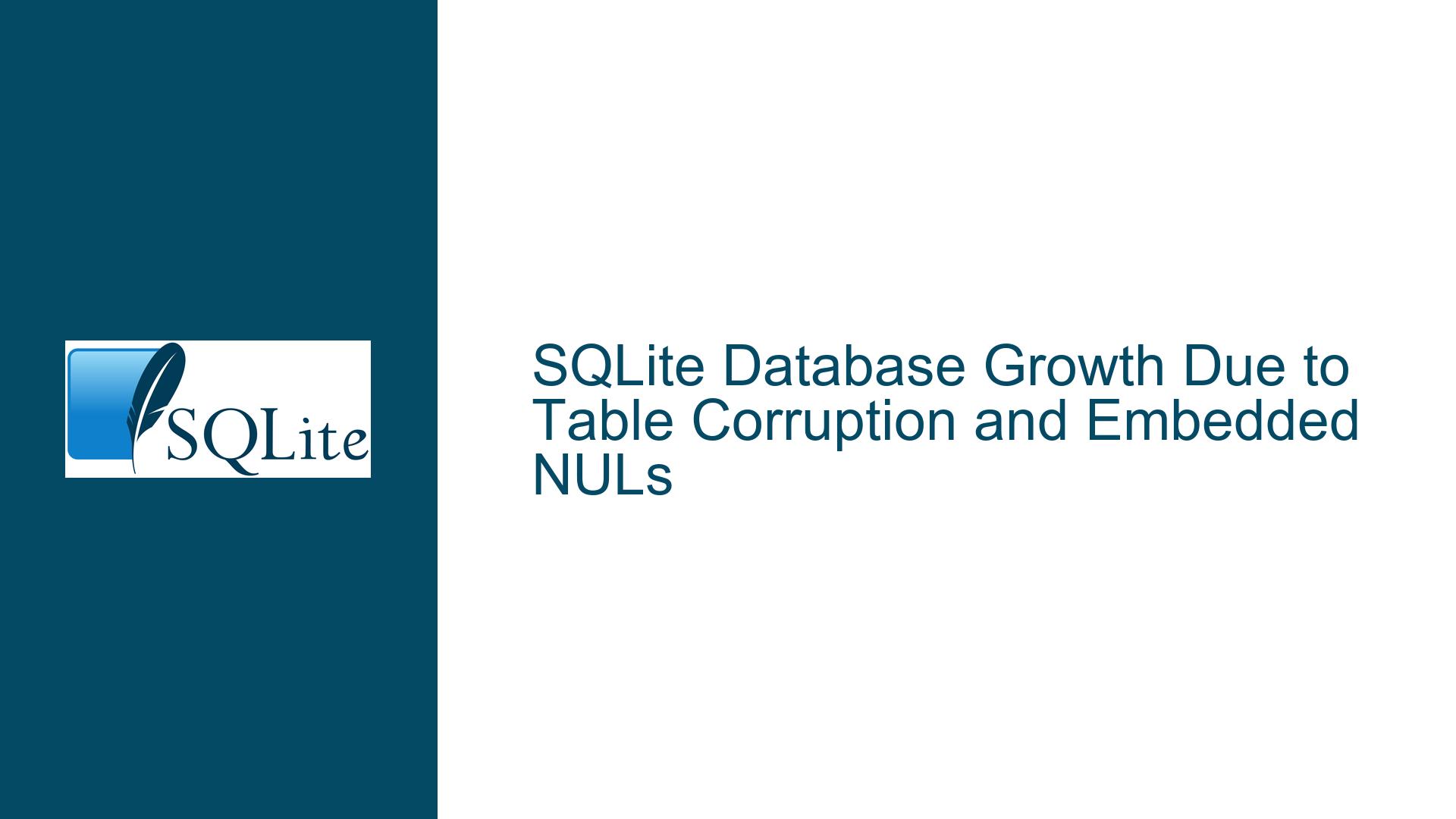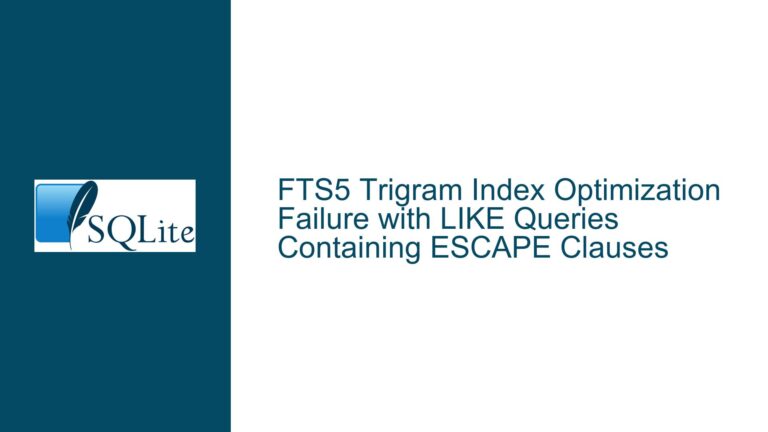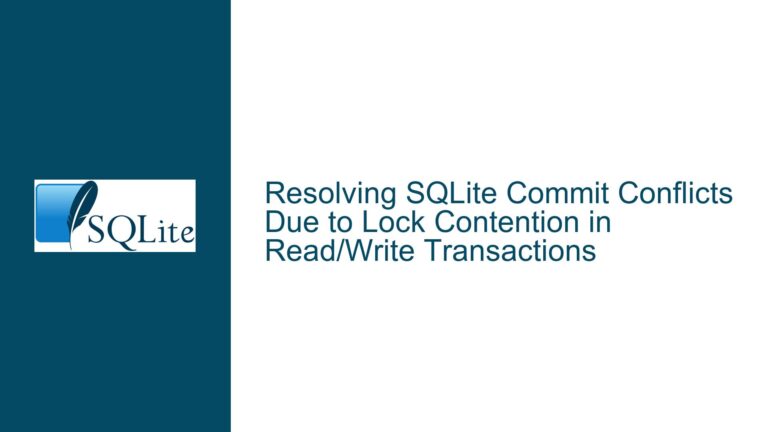SQLite Database Growth Due to Table Corruption and Embedded NULs
Database Growth Despite Minimal Data Insertion
SQLite databases are known for their lightweight and efficient design, but under certain conditions, they can exhibit unexpected behavior, such as rapid and unexplained growth in file size. This issue often manifests when the database file grows significantly larger than the actual data it contains, even when no new data is being inserted. In some cases, the database may grow to several gigabytes despite containing only a few megabytes of user data. This anomaly can be particularly perplexing when tools like the SQLite Analyzer report a small number of records, yet the database file size suggests otherwise.
The root of this problem often lies in the way data is stored and managed within the database. SQLite stores data in a structured format, but certain types of data, such as large binary objects (BLOBs) or text strings with embedded NUL characters (0x00), can lead to unexpected storage behavior. When text strings containing embedded NULs are inserted into the database, SQLite may store the entire buffer provided by the application, even if the string appears to be shorter when queried. This can result in significant storage overhead, as the database allocates space for the full buffer rather than just the visible portion of the string.
Additionally, table corruption can exacerbate this issue. Corrupted tables may contain "ghost records" that are not visible during normal queries but still occupy space within the database file. These records can accumulate over time, leading to bloated database files that do not shrink even after running the VACUUM command. In some cases, attempts to modify or delete records in a corrupted table may fail, further complicating the situation.
Embedded NULs and Ghost Records Causing Storage Overhead
The primary causes of unexplained database growth in SQLite can be traced to two main factors: embedded NUL characters in text data and table corruption leading to ghost records. Both of these issues can result in significant storage overhead, even when the visible data in the database appears minimal.
Embedded NUL Characters in Text Data
When text data containing embedded NUL characters is inserted into an SQLite database, the database may store the entire buffer provided by the application, rather than just the portion of the string up to the first NUL character. This behavior occurs because SQLite treats the provided buffer as a binary object, storing all bytes regardless of their content. For example, if an application inserts a text string with a length of 10,000 bytes, but the string contains a NUL character at the 14th byte, SQLite will still store all 10,000 bytes. This can lead to significant storage overhead, as the database allocates space for the entire buffer, even though only a small portion of the data is visible when queried.
To illustrate this, consider the following example:
char bigBuffer[10000];
strcpy(bigBuffer, "A short string");
sqlite3_bind_text(stmt, 1, bigBuffer, sizeof(bigBuffer), NULL);
In this case, the sqlite3_bind_text function is used to bind a text string to a prepared statement. The fourth parameter specifies the length of the buffer, which is 10,000 bytes. Even though the actual text string is only 14 bytes long, SQLite will store all 10,000 bytes in the database. When queried, the visible portion of the string will appear as "A short string," but the database will still consume 10,000 bytes of storage.
Table Corruption and Ghost Records
Table corruption can also lead to unexplained database growth. Corrupted tables may contain ghost records—entries that are not visible during normal queries but still occupy space within the database file. These records can accumulate over time, leading to bloated database files that do not shrink even after running the VACUUM command.
Ghost records can occur due to various reasons, such as interrupted write operations, software bugs, or improper handling of database connections. When a table becomes corrupted, attempts to insert, update, or delete records may fail, leaving behind incomplete or invalid entries. These entries are not visible during normal queries but still contribute to the overall size of the database file.
For example, a user may attempt to delete a record from a corrupted table, but the deletion operation fails silently, leaving the record in place. Similarly, an insert operation may create a ghost record that is not visible when queried but still occupies space within the database. Over time, these ghost records can accumulate, leading to significant storage overhead.
Diagnosing and Resolving Database Growth Issues
To address unexplained database growth in SQLite, it is essential to diagnose the root cause of the issue and implement appropriate solutions. This process involves identifying embedded NUL characters in text data, detecting and repairing table corruption, and optimizing database storage practices.
Identifying Embedded NUL Characters
The first step in diagnosing database growth issues is to identify whether embedded NUL characters are present in the stored data. This can be done by querying the database and examining the length of the stored strings. The length function in SQLite returns the number of characters in a string up to the first NUL character, but it does not account for embedded NULs. To accurately measure the storage size of a string, including embedded NULs, the string must






